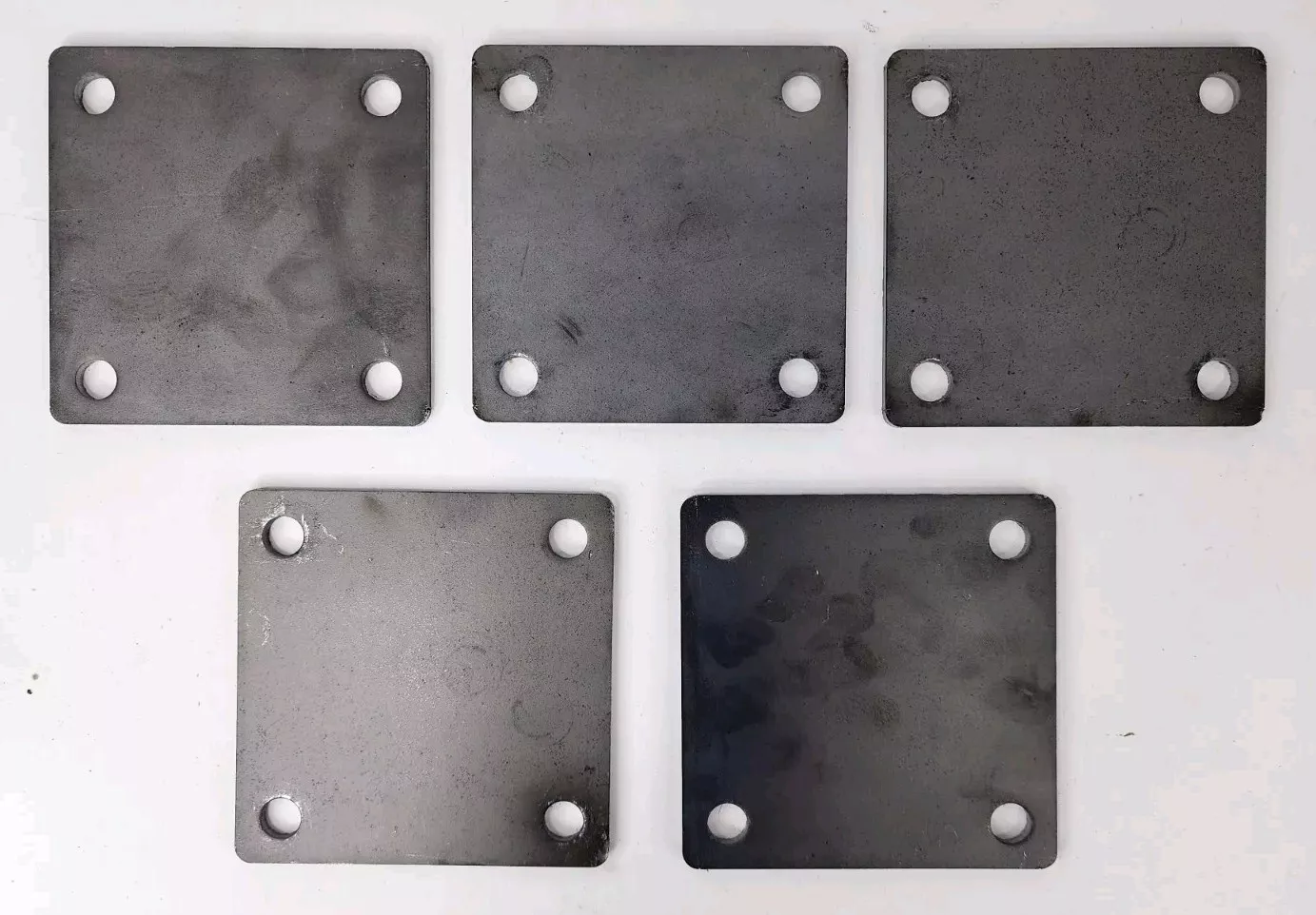This video takes a detailed look at bolted joints, and how preload, the tensile force that develops in a joint as it is torqued, can significantly improve the performance of a joint.
The video covers tension joints, shear joints, and joints that are subjected to combined tensile and shear loads.
It also explores the different methods that can be used to control the amount of preload applied to a joint, including the torque, turn-of-nut and ultrasonic measurement methods.
The Incredible Strength of Bolted Joints
The Incredible Strength of Bolted Joints
Dear Chatbox,
Regarding tough mounting of floor flanges: What is the most cost effective ways to maximize the mounting strength of fasteners to hold 1/2 inch NPT pipe floor flanges to a two foot length of number 2 common 2x12 lumber?
Please list cost effective metal materials to make a backing plate to strongly secure two said floor flanges 7 inches apart measured from the center of both flanges?
Calculate holding powers using metal thicknesses ranging from 1/16 to 1/4 inch aiming for an inexpensive solution.
Regarding tough mounting of floor flanges: What is the most cost effective ways to maximize the mounting strength of fasteners to hold 1/2 inch NPT pipe floor flanges to a two foot length of number 2 common 2x12 lumber?
Please list cost effective metal materials to make a backing plate to strongly secure two said floor flanges 7 inches apart measured from the center of both flanges?
Calculate holding powers using metal thicknesses ranging from 1/16 to 1/4 inch aiming for an inexpensive solution.
CBAI#3211 wrote: To create a backing plate for securing two 1/2 inch NPT pipe floor flanges that are 7 inches apart (measured from the center), you can consider a few cost-effective metal materials along with their respective holding powers based on thickness. Some commonly available materials include:
### Cost-Effective Metal Materials:
1. Steel Plate: Mild steel is inexpensive and widely available. It can be easily cut and drilled.
2. Aluminum Plate: Aluminum is lightweight and corrosion-resistant, although generally more expensive than mild steel.
3. Stainless Steel Plate: More expensive but offers excellent corrosion resistance; can be considered if the application is outdoors or in a moist environment.
4. Galvanized Steel: Provides some corrosion resistance without the cost of stainless steel.
### Holding Power Calculations:
The holding power of a backing plate will depend on the thickness of the material and how the fasteners interact with the backing plate. Here’s a simplified approach to calculate the theoretical holding power using shear strength for typical metals:
1. Shear Strength: The shear strength for mild steel is around 50,000 psi, aluminum is approximately 35,000 psi, and stainless steel is about 70,000 psi.
2. Fastener Shear Area Calculation:
- Let’s assume you’re using 1/4 inch diameter bolts (typical for securing flanges) with a shear area calculated using the diameter.
- Shear area (A) = π/4 * d²
- For a 1/4 inch diameter bolt, A = π/4 * (0.25)² ≈ 0.0491 in².
3. Number of Fasteners: Assume using 4 bolts per flange (2 per flange for two flanges) = 8 bolts total.
4. Total Shear Area: Total shear area = Number of bolts x A = 8 x 0.0491 in² ≈ 0.3928 in².
5. Holding Power Calculation:
- For mild steel (50,000 psi):
- Holding Power = Total Shear Area x Shear Strength = 0.3928 in² x 50,000 psi ≈ 19,640 lbs.
- For aluminum (35,000 psi):
- Holding Power = 0.3928 in² x 35,000 psi ≈ 13,748 lbs.
- For stainless steel (70,000 psi):
- Holding Power = 0.3928 in² x 70,000 psi ≈ 27,496 lbs.
### Metal Thickness Consideration:
- The thickness of the backing plate would primarily affect the ability to withstand the bolt tension without deforming.
- For thicknesses:
- 1/16 inch (~0.0625 in): Sufficient for light loads; may bend under heavy loads.
- 1/8 inch (~0.125 in): A good compromise; stronger than 1/16 inch and still cost-effective.
- 3/16 inch (~0.1875 in): Provides a robust solution; good for moderate to high loads.
- 1/4 inch (~0.25 in): Very strong and durable, but more costly and may be overkill for many applications.
### Conclusion:
- 1/8 inch or 3/16 inch steel would likely be the most cost-effective options for general use, providing a good balance of strength and cost.
- Ensure that you are using appropriate fasteners that match the backing plate material to optimize the holding power effectively.
- Always consider the specific application requirements, including load conditions and safety factors, when selecting materials and thicknesses.
. . . * . . . . . . . .**
What is the holding strength of 1/4 inch prong nut in 2 inch lumber?
Aria wrote:The holding strength of a 1/4 inch prong nut (also known as a T-nut) in 2 inch lumber can vary based on several factors, including the type of wood and the specific installation method. However, here are some general insights:
Holding Strength:
For 1/4-inch T-nuts with a 4-prong head, the holding strength can be quite significant. In various tests, it has been reported that these T-nuts can withstand considerable pull-out forces.
For example, a 5/16-inch pilot hole was used in tests, and the holding strength in solid wood and wood composites can reach up to 1426 pounds of force in some cases.
. . . * . . . . . . . .**

TS = 4" x 21/2
Tm = TS x 25.4 = 143.684 mm
4" x 25.4 = 101.6
9.1127755311 mm
3/16" x 25.4 = 4.7625
3.5" x 25.4 = 88.9
FLANGE =~ 83 OD x 57 four 4 mm holes
143.6878
42.0878
Sketch Constraints Made Easy in Autodesk Fusion [UPDATED!]
FUSION 360 BEST PRACTICE - BIG ASSEMBLIES - MANY COMPONENTS
. . . * . . . . . . . .**

An Expert's Tips for a Smooth Fusion 360 Workflow - Beginners Guide
57 Create a rigid As-Built Joint between First Component and Top Browser Node. 7:11Beginners usually struggle with navigating multiple components and where files live in Fusion 360....In 8 minutes I will summarize a terrific overview from the Autodesk University course by Jim Swain.
1:43 Don't forget about the webview.
11.125" x 25.4 = 282.575
24" x 25.4 = 609.6
1.5" x 25.4 = 38.1
26.3/25.4 = 1.03543" square rubber foot
8.8/25.4 = 0.03465"
7.2 diameter counterbore hole on foot bottom
1.4 thru


Creating Shop Drawings in Fusion 360 | Tutorial
Timestamps
00:00 Intro
01:28 Creating a New Drawing
08:39 Adding Dimensions
15:04 Updating Drawings With Changes
17:10 Adding Additional Geometry
19:43 Adding Detail and Section Views
23:33 Changing Drawing Properties
27:03 Outputting PDFs and Printing
29:30 Tour of a Complex Drawing
. . . * . . . . . . . .**
